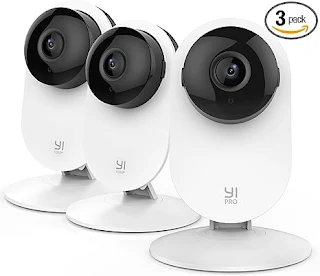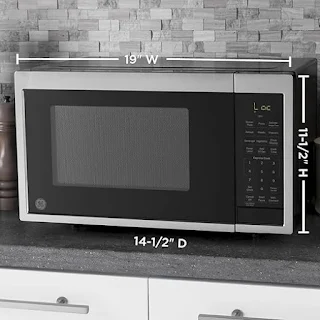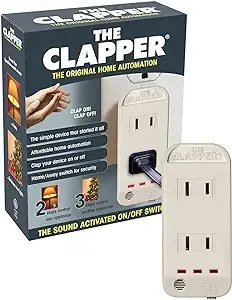Unlocking the Future: Essential Considerations Before Embracing Smart Home Technology
Before delving into the purchase of smart home technology, it's important to consider various aspects.
To save time and facilitate your search on Amazon, we select the best options possible with maximum savings for you. Stay Tuned. Please enjoy.
Each time a new smart home product is discussed, there are often questions raised by commenters regarding the necessity of adding smart features to products they've been using conventionally for years. Some might ask, "What's the issue with a washing machine that doesn't communicate with me?" or "I believe I can outperform any robot vacuum." Others express concerns like, "Do you really want to be monitored through your smart air purifier?" However, there's nothing inherently flawed with the conventional "dumb" products we've grown accustomed to—they simply demand more manual effort on our part.
Amazon Smart Thermostat – Saves money and energy - Works with Alexa and Ring - C-wire required
To secure this price, place this item in your basket to pay later or remove it if you find something more suitable.
For more detailed information, please click here (price may vary buy now)
The potential benefits of smart products are extensive. They offer time savings by operating autonomously, as well as cost savings since they can be programmed with both human intelligence (experience) and artificial intelligence. Moreover, they can be enjoyable; there's a certain satisfaction in issuing a voice command and witnessing lights illuminate, doors secure, the dryer commence, or a robot mop glide into action. Yet, perhaps the most compelling reason—the one that's difficult to dispute—is that smart home products enhance accessibility. We'll inevitably all be utilizing them shortly; however, there are crucial considerations to address before fully embracing them.
A robust and reliable Wi-Fi connection is essential for smart home devices to function effectively. While it's possible to eventually operate them using local signals such as Bluetooth, Z-Wave, and Zigbee, this isn't the standard practice. Setup typically necessitates Wi-Fi, and usage often relies on internet connectivity as well.
GHome 4 IN 1 Smart Fingerprint Door Knob with Keypad Door Lock, Biometric Smart Door Knobs & App Control, Keyless Entry Door Lock Great for Home, Bedroom, Apartment Offices and Garages
To secure this price, place this item in your basket to pay later or remove it if you find something more suitable.
For more detailed information, please click here (price may vary buy now)
It's not merely a matter of having strong Wi-Fi; consistency throughout the areas where smart products are used is crucial. Achieving this can be challenging, especially in large spaces or areas obstructed by barriers like metal walls or bulky appliances. One common solution is to deploy mesh routers, which excel in evenly distributing Wi-Fi signals across a given space.
Not all smart home technologies are easily transportable to your next residence. While some devices like Tiles can be effortlessly relocated, others pose more challenges. For instance, moving voice assistant speakers or hubs can be cumbersome. Similarly, transferring lightbulbs and smart appliances may not be straightforward.
Brilliant Smart Home Control (3-Switch Panel) — Alexa Built-In & Compatible with Ring, Hue, Google Nest, Wemo, SmartThings, Apple HomeKit — In-Wall Touchscreen Control for Lights & Music (Renewed)
To secure this price, place this item in your basket to pay later or remove it if you find something more suitable.
For more detailed information, please click here (price may vary buy now)
As the trend shifts towards smart switches over hubs, it's essential to weigh the permanence of your investments. While items like robot pool cleaners might accompany you to your new home, others like smart garage openers may not. Therefore, it's crucial to consider the longevity of your choices when investing in smart home technology.
Privacy breaches are an unfortunate reality when it comes to smart home technology. While we should ideally be able to enjoy the convenience of smart products while maintaining our privacy, it's crucial to acknowledge the vulnerabilities inherent in these systems. Companies can make mistakes, networks can be compromised, and security breaches do occur.
Echo Dot (5th Gen, 2022 release) | With bigger vibrant sound, helpful routines, and Alexa | Glacier White
To secure this price, place this item in your basket to pay later or remove it if you find something more suitable.
For more detailed information, please click here (price may vary buy now)
While it's important not to simply accept privacy breaches as inevitable, it's also essential not to let them cause undue anxiety. It's a delicate balance. Many individuals already grapple with concerns about online security, whether it's entering credit card information or using sensitive personal data for identification. Despite these risks, younger generations have largely embraced online transactions as a standard part of modern life, recognizing that occasional risks are inherent in the digital landscape.
Ultimately, as with online transactions, the evolution of smart home technology will likely involve improving fraud protection and security measures to mitigate the risks associated with privacy breaches. Being aware of these risks is important, but it's also crucial not to let them overshadow the benefits and potential of smart home technology.
Selecting a primary hub is crucial amidst the plethora of options available in the market. While multiple system hubs exist, and the ecosystem continues to expand, it's prudent to opt for one main hub for streamlined management. Although running multiple systems concurrently (like HomeKit and Alexa, Alexa and Google Home, SmartThings and Home Assistant, etc.) is feasible, focusing on one voice assistant (be it Siri, Google, or Alexa) and sticking with a single hub is advisable.
Consolidation simplifies product management through automation and the hub's application, facilitating decisions regarding smart speakers and displays. The optimal selection process involves considering your priorities and tinkering preferences. For instance, if you're an Apple enthusiast, HomeKit might align well with your preferences, although not all products are compatible with it. In my opinion, Alexa boasts the most robust ecosystem; however, if you prioritize absolute control, Home Assistant could be the better fit.
Amazon Fire TV Stick Lite, free and live TV, Alexa Voice Remote Lite, smart home controls, HD streaming
To secure this price, place this item in your basket to pay later or remove it if you find something more suitable.
For more detailed information, please click here (price may vary buy now)
Emerging hubs like Hubitat and Brilliant offer diverse levels of control and product integration, catering to varying needs and preferences. Therefore, carefully evaluating your requirements and preferences will guide you in selecting the most suitable hub for your smart home setup.
Introduce smart home technology gradually, layer by layer, rather than diving in all at once. Begin by selecting a hub, then focus on implementing one layer of utilities: lights, HVAC, or cleaning. If opting for lights, decide between smart switches, fixtures, or lightbulbs (or a combination), but aim to minimize the number of brands used and progress slowly. Explore automation, voice control, and contingency plans for connectivity issues as you go along. Gradually incorporate additional layers as you become more comfortable with the technology.
Newentor Weather Station Wireless Indoor Outdoor Thermometer, Color Display Digital Weather Thermometer with Atomic Clock, Barometric Pressure, Forecast Station with Adjustable Backlight, Black
To secure this price, place this item in your basket to pay later or remove it if you find something more suitable.
For more detailed information, please click here (price may vary buy now)
An inevitable aspect of smart home integration is the proliferation of additional apps and physical hubs, which can become overwhelming. To streamline management, designate a central location for the hubs and clearly label them to indicate their respective functions. Additionally, maintain a document or spreadsheet listing all installed apps on your phone and their associated controls for easy reference and organization. This approach ensures efficient management and a smoother transition to smart home living.
Google Nest Learning Thermostat - Programmable Smart Thermostat for Home - 3rd Generation Nest Thermostat - Works with Alexa - Stainless Steel
To secure this price, place this item in your basket to pay later or remove it if you find something more suitable.
For more detailed information, please click here (price may vary buy now)
Indoor Camera 2K, Litokam 360 Pan/Tilt Smart Home Security Camera for Pets/Dog with Phone App, Baby Camera with Motion Detection, 2.4G WiFi Camera with Night Vision & 2-Way Audio, Works with Alexa
To secure this price, place this item in your basket to pay later or remove it if you find something more suitable.
For more detailed information, please click here (price may vary buy now)
YI Pro 2K 3PC Home Security Camera, Indoor Camera with Person, Vehicle, Animal Smart Detection, Phone App for Baby, Pet, Dog Monitoring, Works with Alexa and Google Assistant
To secure this price, place this item in your basket to pay later or remove it if you find something more suitable.
For more detailed information, please click here (price may vary buy now)
$79.99
YoLink Smart Home Starter Kit: Hub & Water Leak Sensor 4-Pack, SMS/Text, Email & Push Notifications, LoRa Up to 1/4 Mile Open-Air Range, w/Alexa, IFTTT, Home Assistant
To secure this price, place this item in your basket to pay later or remove it if you find something more suitable.
For more detailed information, please click here (price may vary buy now)
Compatibility: Ensure that the smart devices you're eyeing are compatible with your current ecosystem, whether it's Google Assistant, Amazon Alexa, Apple HomeKit, or another platform.
Security: Investigate the security measures implemented by the manufacturer to safeguard your data and privacy. Look for features such as encryption, regular firmware updates, and robust password protection.
Integration: Evaluate how well the device integrates with other smart home devices you already own or plan to acquire. Seamless integration enhances the overall functionality of your smart home setup.
User Interface: Assess the user interface of the device and associated apps. A user-friendly interface simplifies the setup, configuration, and control of your smart devices.
Reliability: Read reviews and user feedback to gauge the reliability and performance of the product. Opt for devices with a proven track record of stability and longevity.
Cost: Consider the total cost of ownership, including initial purchase price, ongoing subscription fees (if applicable), and potential additional expenses like installation or maintenance.
Energy Efficiency: Determine whether the smart device contributes to energy conservation and cost savings over time. Energy-efficient devices can lead to lower utility bills and reduced environmental impact.
Scalability: Anticipate your future needs and assess whether the device can scale with your expanding smart home setup. Choosing scalable products ensures compatibility and flexibility as you add more devices.
Support and Warranty: Check the manufacturer's warranty and customer support options. Reliable support and a comprehensive warranty offer reassurance and assistance in case of issues or malfunctions.
Data Privacy: Understand how the device handles your personal data, including collection, storage, and usage. Opt for products from reputable manufacturers with transparent privacy policies and robust data protection measures.
User Reviews: Seek out unbiased user reviews and ratings online to gain insights into real-world experiences with the product. Pay attention to both positive and negative feedback to make an informed decision.
Interoperability Standards: Verify whether the device adheres to industry standards and protocols for interoperability, such as Zigbee, Z-Wave, or Thread. Interoperable devices offer greater compatibility and flexibility with various smart home systems.
By carefully considering these factors, you can make informed decisions when selecting smart home technology that aligns with your needs, preferences, and budget.
“As an Amazon Associate, I earn from qualifying purchases.”
































.png)

Comments
Post a Comment